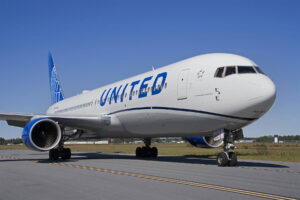Last edit by: WineCountryUA
This is an archive thread, the active thread is United Pilot Q & A thread
United Pilot Q & A {Archive}
#2251
Join Date: Jun 2006
Location: SJC
Programs: UA MM
Posts: 1,197
Well, we are not talking about 5 minutes early, but when congestion disappears (and it has been a lot less congestion lately due to a massive reduction of flights) we are talking about potentially arriving 30-40 minutes on some flights early with the massive block times UA operates with. We still have a 2:40 block time for UA between LGA-ORD and UA is using every second of it while AA has block times of 2:20, 2:30 at the most. (why is that anyways? Is that UAs strategy to have 2:40 block time for 730 miles just to make sure they meet their on time performance?)
To dilly dally at .75/76 to save gas, leave on time, fly 2:40 and land on the dot getting to the gate on time when you could have arrived 30 minutes early is something I as a customer find annoying when you know that cruising at the aircrafts normal speed could have gotten me home early (.76 is not normal speed).
To dilly dally at .75/76 to save gas, leave on time, fly 2:40 and land on the dot getting to the gate on time when you could have arrived 30 minutes early is something I as a customer find annoying when you know that cruising at the aircrafts normal speed could have gotten me home early (.76 is not normal speed).
If you go to a site that shows actual recorded data for flight times, you'll see that UA's flight (not block) times LGA-ORD over the last week have been consistently 2-5 minutes faster than AA's.
#2252
Join Date: Jan 2008
Posts: 3,123
Wow, that's is incredible. So the fictious scenario of Airport 1975 would never happen in modern aviation?
http://en.wikipedia.org/wiki/Airport_1975
http://en.wikipedia.org/wiki/Airport_1975

#2253
Join Date: Feb 2002
Location: BNA
Programs: HH Gold. (Former) UA PP, DL PM, PC Plat
Posts: 8,197

Did the 747-100, the aircraft used in the film, ever have autoland?
Last edited by FlyinHawaiian; May 25, 2009 at 10:19 pm Reason: fix html
#2254
Join Date: Feb 2006
Location: SFO
Programs: UA1P
Posts: 613
Fresh answered this pretty good. There are a lot of things that have to be working for us to do autolands. The airport has to have its ILS system working, and runway lights working correctly. The plane has to have all it's required equipment working and be current in autolands, and then the pilots have to be current and qualified as well.
#2255
Join Date: Sep 2000
Location: Denver, CO
Programs: UA 1K 25 years/2MM, Honors LT Diamond, AVIS & Hertz Prez Club
Posts: 4,755
Just a comment about autolands. My most vivid memory of one was SFO-BOS in a UA 762 a number of years ago. We were in dense fog and ATC had warned all incoming aircraft of "tall ships" in the harbor for approaches. It was pea soup out there and somewhere close to landing we executed a go around. The captain asked ATC for an alternate approach and one was given. After setting up for it, he radioed he would be performing an autoland. I watched out that window the whole time, our headlamps were on, it was 2300 EST at the time, and you couldn't see a thing until 5 seconds before touch down. Then all we could see were some faint lights immediately under us on the runway. I didn't even see any terminal buildings until we had left the active runway. It was a really impressive landing and from a layman's perspective, it must have been CAT III.
I'll never forget hearing about the "tall ships" warning... ever hear of that before?
I'll never forget hearing about the "tall ships" warning... ever hear of that before?
#2256
Join Date: Oct 2008
Programs: UA 1P
Posts: 129
The "tall ships" warning probably refers to large sailing ships. Their masts are considerably taller than normal obstructions in the harbor.
#2257
Join Date: Sep 2000
Location: Denver, CO
Programs: UA 1K 25 years/2MM, Honors LT Diamond, AVIS & Hertz Prez Club
Posts: 4,755
Aye, that's what I assumed... I wondered how common that is and just how high the masts are and how low the planes are that it is even a concern.
#2258
Join Date: Feb 2009
Location: YYC
Posts: 495
Looking at a satellite picture, only runways 27 and 33L have their thresholds right next to the water, and 33L has some kind of structure holding approach lights quite a distance into the water.
In my extremely unprofessional and uninformed opinion, likely not much of a problem!

#2259
Join Date: Jan 2008
Posts: 3,123
From what I've heard from other airline pilots, the airplane has to be configured (ie, airspeed, flaps/slats, landing gear, autopilots engaged, ILS's tuned in, etc.) further out than a visual approach. This slows down the rate at which an airport can accept incoming aircraft. As such, you will only get a CAT III approach if it requires it or the airport and ATC are really quiet and the pilots request it for certification purposes. This happens on a regular basis typically on the late arriving flights. Autolandings can also impact outgoing flights. The outbound a/c typically hold short of the runway in ILS Critical Areas and their presence can affect the glide slope (vertical guidance part of the ILS). In visual conditions, not a factor for landing a/c but for autolands, the tower needs to have the holding a/c outside of this critical area. BTW, the Glide slope is typically located by the runway aiming point (the two big solid white markings on the runway) and about 200 feet off the centerline.
As for the ILS Critical area, that has no affect on delays or spacing. Usually the critical area is only a couple hundred feet prior to the normal hold short line, so planes just hold behind that line for takeoff. Adds 30 sec to a taxi out to the runway maybe, so no issue overall.
Just a comment about autolands. My most vivid memory of one was SFO-BOS in a UA 762 a number of years ago. We were in dense fog and ATC had warned all incoming aircraft of "tall ships" in the harbor for approaches. It was pea soup out there and somewhere close to landing we executed a go around. The captain asked ATC for an alternate approach and one was given. After setting up for it, he radioed he would be performing an autoland. I watched out that window the whole time, our headlamps were on, it was 2300 EST at the time, and you couldn't see a thing until 5 seconds before touch down. Then all we could see were some faint lights immediately under us on the runway. I didn't even see any terminal buildings until we had left the active runway. It was a really impressive landing and from a layman's perspective, it must have been CAT III.
I'll never forget hearing about the "tall ships" warning... ever hear of that before?
I'll never forget hearing about the "tall ships" warning... ever hear of that before?
Some autolands can be down to less than 1/16 of a mile vis, so you won't even see the runway when you land, you just land. Taxiing in that weather is the hard part, using what's called the Surface Movement Ground Guidance system to taxi around the airport. It is a series of lights and ground checkpoints to tell everyone where you are, or so that Ground can use their radar to follow you to specific points. It can take along time to taxi using SMGS to the gate.
#2260
Join Date: Feb 2002
Location: BNA
Programs: HH Gold. (Former) UA PP, DL PM, PC Plat
Posts: 8,197
Here's a video of what a CAT III autoland approach looks like from the cockpit of a B767.
http://www.youtube.com/watch?v=EgeT-F9-1KI
You'll hear a few calls...
"200, Land 3" That's 200' above touchdown. Land 3 is the autopilot/autoland status.
"100, Land 3" 100' above touchdown.
"50" 50 feet above touchdown
"30" 30 feet above touchdown
You can hear the touchdown.
http://www.youtube.com/watch?v=EgeT-F9-1KI
You'll hear a few calls...
"200, Land 3" That's 200' above touchdown. Land 3 is the autopilot/autoland status.
"100, Land 3" 100' above touchdown.
"50" 50 feet above touchdown
"30" 30 feet above touchdown
You can hear the touchdown.
#2261
Moderator: Smoking Lounge; FlyerTalk Evangelist
Join Date: Feb 2004
Location: SFO
Programs: Lifetime (for now) Gold MM, HH Gold, Giving Tootsie Pops to UA employees, & a retired hockey goalie
Posts: 28,882
Here's a video of what a CAT III autoland approach looks like from the cockpit of a B767.
http://www.youtube.com/watch?v=EgeT-F9-1KI
You'll hear a few calls...
"200, Land 3" That's 200' above touchdown. Land 3 is the autopilot/autoland status.
"100, Land 3" 100' above touchdown.
"50" 50 feet above touchdown
"30" 30 feet above touchdown
You can hear the touchdown.
http://www.youtube.com/watch?v=EgeT-F9-1KI
You'll hear a few calls...
"200, Land 3" That's 200' above touchdown. Land 3 is the autopilot/autoland status.
"100, Land 3" 100' above touchdown.
"50" 50 feet above touchdown
"30" 30 feet above touchdown
You can hear the touchdown.
 (yeah, i know, for you it's just a walk in the pahk <--boston accent
(yeah, i know, for you it's just a walk in the pahk <--boston accent  )
)
#2262
Join Date: Jan 2009
Posts: 1,188
Not sure if this is the right place, but it would be related
anyone knows the 26 words that pilots use (or the industry use) to represent the alphabet?
Like C for Charlie (thats the one I can remember)
thanks
anyone knows the 26 words that pilots use (or the industry use) to represent the alphabet?
Like C for Charlie (thats the one I can remember)
thanks
#2263
Join Date: Oct 2008
Programs: UA 1K, AA Plat, SPG Platinum, National Executive
Posts: 1,970
Let's see how I do... (it's called the phonetic alphabet)
Alpha
Bravo
Charlie
Delta (Dixie in ATL for obvious reasons)
Echo
Foxtrot
Golf
Hotel
India
Juliet
Kilo
Lima
Mike
November
Oscar
Papa
Qubec
Romeo
Sierra
Tengo
Uniform
Victor
Whiskey
X-Ray
Red Sox
Zulu
Alpha
Bravo
Charlie
Delta (Dixie in ATL for obvious reasons)
Echo
Foxtrot
Golf
Hotel
India
Juliet
Kilo
Lima
Mike
November
Oscar
Papa
Qubec
Romeo
Sierra
Tengo
Uniform
Victor
Whiskey
X-Ray
Red Sox
Zulu
Last edited by UAX_Brasilia; May 25, 2009 at 3:53 pm Reason: spelled romeo wrong
#2264
Join Date: Jan 2009
Posts: 1,188
but why Red Sox for Y? wouldnt Yankee be more better
Last edited by JALlover; May 25, 2009 at 4:01 pm
#2265
Join Date: Oct 2008
Programs: UA 1K, AA Plat, SPG Platinum, National Executive
Posts: 1,970
I was joking...it is Yankee.






















